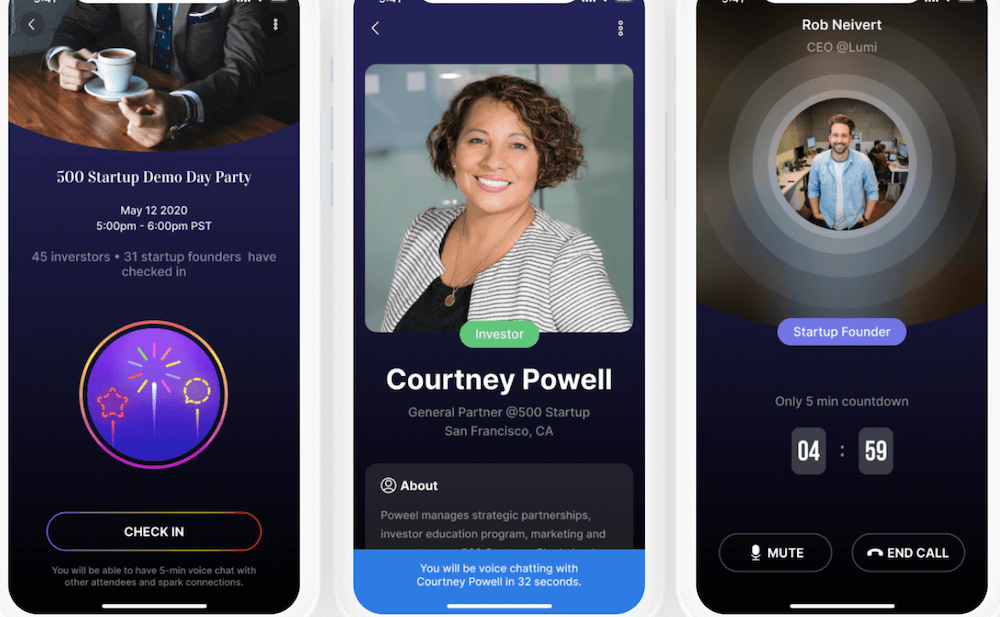
Run the World co-founders Xiaoyin Qu (left) and Xuan Jiang, are former Facebook employees.
In the three-and-a-half months since former Facebook employees Xiaoyin Qu and Xuan Jiang launched the digital event-tech startup Run the World, the company’s growth has mirrored the meteoric rise in the number of online meetings created during the pandemic — the app-based platform has been used to organize more than 2,400 meetings with attendees from more than 40 countries.
Qu left Stanford Graduate School of Business last year to start Run the World, relying on resources including PCMA’s CMP online course to immerse herself in the events industry. The Silicon Valley–based startup launched with funding from the venture capital firm Andreessen Horowitz, an early investor in such companies as Skype and Airbnb. Last month, Run the World received another round of capital from Andreessen Horowitz , and participation from investors including celebrities Will Smith and Kevin Hart and founders of companies including Doordash, Patreon, and Whatsapp.
Convene asked Qu what she has learned in the last few months about digital events:
On getting attendee attention: It’s easy to organize online events and “there is a lot of competition out there,” Qu said. It’s also easier to track and measure attendee engagement, unlike at physical events, where an attendee might lose interest in the content but stay in their seat, looking at their phones, she said. When online attendees get bored, “they’re out,” Qu said. “The engagement requirement is more than just you have to be more interesting than another Zoom webinar or more interesting than another person who is doing an event,” she said. You have to be more be as engaging as whatever YouTube video might draw an attendee’s attention — “a very high bar,” Qu added. Conference content is never going to be as compelling as a Netflix drama, so “you can’t just have attendees passively watching,” she said. “There needs to be interactive component to it.”

Run the World’s “cocktail party” can be used to set up meetings for up to eight people.
Finding the right business model: During the first month following the company’s launch in late February, most organizers offered their events on the platform for free. They weren’t sure what — or whether — to charge participants, Qu said. That’s changing, she said, as organizers begin to rethink questions around the value of digital events. “They are asking, ‘What is the value that people are paying me for?’” In the “old world” of face-to- face events, attendees were happy to pay for the speakers — having Beyoncé presenting a keynote, for example, was a big deal. But in the new online world, why would you pay to see Beyoncé onscreen when you can get that for free on YouTube? Asks Qu. One response, she said, is to ask speakers to personalize content to attendees.
But planners also are either being forced to or are actively pursuing new engagement formulas, she said. One of them is Run the World’s “cocktail party” feature, which allows users to talk one-on-one or in small groups of up to eight people, and surprised Qu and her cofounder by becoming the platform’s most popular element.
Some organizers are finding that people value the connections they make even more than content from online presentations, Qu said. The company’s research indicates that as much as half of the value of attending face-to-face events is around the expectation that attendees will meet relevant people, she said. “One thing we’ve learned is that you can’t just say, ‘I have a networking feature’ and check off a box, and then throw out the tool [to everyone] and say: ‘Here, engage.’ People won’t use it.” The context needs to be established by organizers, she said, who make it comfortable and socially acceptable for attendees to contact each other.
One-on-one or small-group networking can be used in multiple ways, including around content during breaks between sessions, and in matching exhibitors with potential customers, she said. The opportunities for such engagement are leading online event organizers to rethink revenue models, she said. One emerging trend is for organizers to make the free, but then generate revenue from the opportunities people have to meet afterwards, she said. The organizer’s job then becomes curating those connections well, she said. “If attendees can spend an hour and connect with all the people that they want to meet, that’s actually extremely valuable.”
Rethinking the definition of “event”: Moving events from geographic locations to online has created shifts in thinking around content and communities. Some forward-thinking organizers, Qu said, have realized, “‘Hey, wait a minute, why do we need to have our event only once a year? Why not create recurring events that will build longer-term relationships between people and secure sponsorship revenue — not per event, but on an annual basis?’”
Agendas are also adapting to online attention patterns. Multi-track agendas presented at the same time online almost always translates into lower attendee numbers per session, Qu said. Multiple tracks might make sense sometime, but the trend is toward sessions presented at different times, she said. The data shows that in terms of creating engagement, a three-hour-long event is optimal for attention spans, she said. But it’s not a hard-and-fast rule. “You can do five hours where everyone is fully engaged, she said. “You can do one hour, where everyone is bored.”

Run the World has added a “selfie” feature to its digital event platform.
Embedding ritual and connection into online events: As everything from events to talking to family members to socializing with friends has migrated to Zoom, there is a sameness to everything, Qu said. Adding to that is the fact that online events have lost tangible, ceremonial aspects that once naturally accompanied face-to-face events — things “like going to a fancy reception, or getting your badge, or checking into your hotel,” she said.
One of the ways that Run the World helps attendees connect more experientially with one another is through a “video handshake” — participants create a short video of themselves that they can use for their introductions. Organizers are discovering that the videos don’t need to be bland; they can be used in interesting ways to bring ritual to online events, Qu said. Attendees can all dress up as if they were going to the prom for a networking session, or wear clothing in the same color, or hold up slogans based around a theme, she said.
“We see a lot of people sharing screenshots of those features and posting them to Twitter to talk about the events they have gone to,” Qu said. “Why not double down on that and enable more of those moments for people? The lowest-hanging fruit is to create some kind of a group selfie, that participants can share on social media.”
